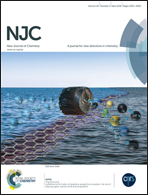A photostable fluorescent probe for rapid monitoring and tracking of a trans-membrane process and mitochondrial fission and fusion dynamics†
Abstract
Rapid monitoring and tracking of a trans membrane process and mitochondrial fission and fusion dynamics play critical roles in judging the occurrence and development of disease, and can give insights for studying apoptosis and cell degeneration. However, the existing probes are not capable of rapid monitoring and tracking the above dynamics process. To solve this problem, we develop a unique functional mitochondria probe containing long alkyl chains, 3,5-bis((E)-2-(pyridin-4-yl)vinyl)-1H-indole monoiodide (MT-PVIM), which is capable of rapid real-time imaging and tracking mitochondrial fission and fusion dynamics. In addition, compared with a commercially available mitochondrial probe MTR, the MT-PVIM probe has excellent specificity to mitochondria with outstanding tolerance of micro-environmental changes, thus representing a potential candidate as a tracking agent for apoptosis studies. The good performance of our proposed approach demonstrates that this strategy might open up new opportunities for the development of rapid image mitochondria-targetable molecular tools for bioanalytical and biomedical applications.


 Please wait while we load your content...
Please wait while we load your content...